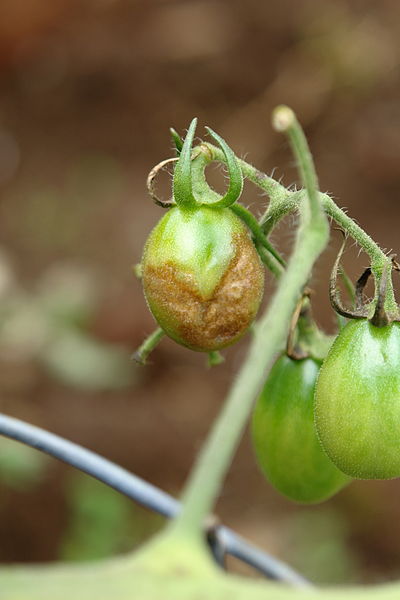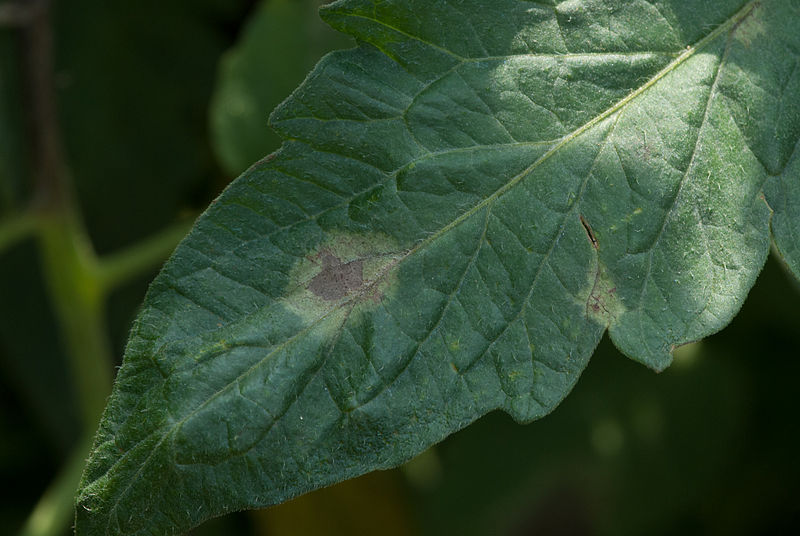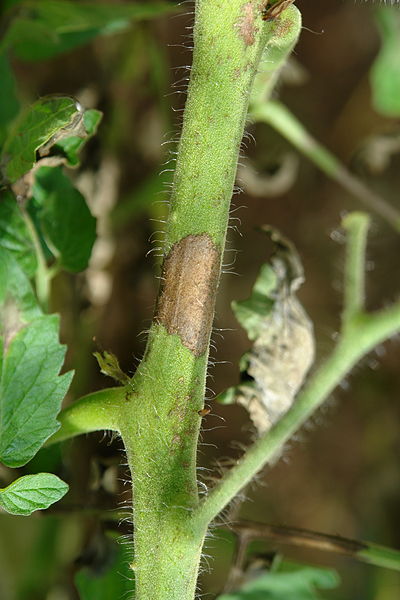Preventing Late Blight in Tomatoes

Bob Wildfong
Of all the problems that can affect your tomatoes, late blight is the most heartbreaking. It's a disease that comes late in the season, after you've invested lots of work in your beautiful tomato plants, and it starts as a few little brown spots that you probably won't notice. Then within a few weeks it destroys everything: the leaves, the stems, and the tomatoes.
This is a disease that has caused catastrophe, been despised by history, and is fittingly named in Latin: Phytophthora infestans, literally the "Attacking Plant Destroyer".
Late blight has been around for a long time, mostly causing problems for tomatoes and potatoes. It's the fungus that caused the Irish Potato Famine, and it's been found throughout North America wherever potatoes and tomatoes have been grown (remember, those plants are originally from the Western hemisphere so their diseases were around here long before they appeared in Ireland). But something has changed recently. Late blight is showing itself in tomatoes and potatoes more than ever during recent years.
Part of the problem is that new strains have appeared during the past ten years that are able to overwinter in our cold climate. Old-fashioned late blight was killed by cold temperatures, so it might have been carried into your garden on an infected potato or tomato seedling, and caused its massive damage that season, but it would die out over winter. Now, the disease comes back year after year, because the new strains can live in old plant tissue, even frozen.
Another part of the problem might be that we're getting more late-blight-loving weather. Once the fungus has infected a tomato plant, it can multiply to infect others. But it prefers to do that when temperatures are cool, and the plants are wet. In years past, midsummer nights tended to stay warm, so blight would spread slowly, but recently we've had a lot more fluctuations of temperature and rainfall, causing more wet, cool nights during July. (Some of you will deny any observations of wet weather this year, and you're correct, but think back to other rainy years).
This is the hidden danger of climate change. We're not just experiencing global warming, we're experiencing greater fluctuations of temperature from hot to cold and back again. Sure, there have been a lot more hot days in recent years, but there have also been a lot more cool nights. Under climate change, the temperature moves further up and down in both directions. So no matter what temperature a particular disease prefers, it's more likely to get it. In the case of late blight, the fungus has been given its favourite conditions: cool nights in July, even when those same days have been unbearably hot.
Recognising Late Blight on Tomatoes
Late blight starts with little brown spots on the lower leaves of your tomato plants. Usually, it gets there when rain splashes soil up onto the leaves (though driving rain or windy mist can carry spores from other infected plants). If the fungus spores are in the soil, you'll first see late blight spots on the leaves in the splash zone at the bottom of the plant.
The brown spots are colonies of late blight fungus, which produce spores and release them into the air. That's when things get bad. Spores can be produced in as little as 5 days under those ideal cool, wet conditions, so before you realize what's happening, you can have two or three generations of infection. That's enough to cause browning leaves, horrible stem lesions, and browning tomato fruit on all parts of every plant, in just a few weeks. And once that happens, there is no cure.
Still, before you get too alarmed, there are lots of reasons why leaves can turn brown. There are other tomato diseases that are, while annoying, not fatal. And plain old drought stress can make the lower leaves of your plants turn brown.
So here are two things to look for:
- If the brown spots on the lower leaves are caused by late blight, they will probably have fuzzy white margins. Those are the new spores getting ready to infect your whole garden. If you don't see the white growth in the image here, it might still be late blight, but maybe not.
- When late blight starts to advance in tomatoes, it almost always shows brown-black stem lesions. That's a sure sign, because other typical causes of brown leaves won't make the stems look that way.
|
Brown spots on the leaves usually have fuzzy white margins |
Stem lesions are a sure sign of late blight |
If you don't have late blight, try to figure out what you do have. The Internet has many gory pictures of dying tomato plants that you can compare, and straightforward directions on what to do.
If you do have late blight, get rid of it.
Get Rid of It
Sadly, once a tomato plant has serious symptoms of late blight it rarely bears good fruit. The disease just advances too fast for any recovery.
Usually, the best thing you can do is to rescue your next-year's garden by removing the infected plants from your garden this year, including stems, fruits, and as many leaves as possible. It's recommended that you double-bag them and put them in the garbage, instead of composting. While it's possible that composting can kill disease organisms, if it doesn't actually get hot enough to do that you run the risk of spreading the disease everywhere that you put the compost later.
Some strains of late blight can survive in the dead tissue of old tomato plants, even as they decompose underground, and even over winter. Remember, any diseased plants that you leave in the garden will be able to re-infect your tomatoes next year.
Keep It Off the Plants
Frankly, it's hard to remove every single bit of the old infected plants. Some bits will inevitably remain in the garden. The next best defense is to grow something of a different plant family, such as root crops or cabbage family crops, in the area where tomatoes previously had late blight. Plant the tomatoes far away, where the soil won't have late blight lurking in it. That's sensible, but unfortunately it only works if you have a very large garden. Crop rotation doesn't work very well over a distance of less than 50 feet or so; infected tomato leaves can easily scatter and blow around, so you have to assume that anywhere in a typical urban backyard would be susceptible to last year's blight.
The next defense is to contain the disease in the ground, and keep it off your plants. A major vector for the initial infection is from soil splashing on the lower leaves during heavy rain, which carry spores that make those first brown spots. Have you ever noticed after a hard rain that you can see splashed soil on plants and fences in the garden up to about 8-10 inches from the ground? That splash zone is where infected soil will infect your tomato plants. Fortunately, a good mulch will completely prevent the soil from splashing.
Whether you use straw, leaf mulch, newspaper, horticultural plastic, or fabric, any good barrier on the ground around your tomato plants will keep the soil from splashing up. Even if the night is cool and the plants are wet (ideal conditions for late blight infection), the nasty spores will be stuck safely under the mulch.
But Don't Mulch Too Early
Just a word of warning about mulching tomatoes, though. While mulch helps prevent blight, helps retain moisture, and keeps weeds down, it also cools the soil. If you mulch tomatoes in spring, at the same time you plant them, the cool soil will slow their grown and make them ripen late. Instead, plant your seedlings in bare soil and let the ground heat up for about a month before mulching.
Resistant Varieties
A great way to avoid late blight is to grow resistant varieties. Unfortunately, there are no tomato varieties that are completely immune to late blight, but some are better than others. Interestingly, the resistant varieties are not all modern introductions. A lot of heritage varieties are resistant too. That makes sense when you consider that the late blight fungus evolved in the same region as tomatoes and potatoes (Central and South America).
You can imagine wild tomatoes and potatoes growing for millennia before farmers invented themselves. The plants were natural hosts for diseases, and the diseases forced the plants to breed their own resistances. So there are natural late-blight resistance genes in some heritage tomatoes, though not all of them.
Some of the heritage varieties that show natural late-blight resistance include Matt's Wild Cherry, Black Plum, Tigerella, Red Currant, Yellow Currant, Stupice, and Old Brook. Of course, many of the hybrid varieties marketed as resistant to late blight are crosses of high-yield varieties and older varieties with resistance genes. You can find others easily - two years ago I grew an unnamed yellow cherry tomato in a field where every other tomato variety was killed by late blight, but the yellow cherry didn't have a single brown spot on the leaves. (Members, I'll offer it in the Seed Directory as "German Yellow Cherry tomato").
Whether the recent increase in late blight has been caused by new strains of the fungus, or the blight-friendly midsummer weather brought by climate change, we have seen a remarkable shift in the way market gardeners produce their tomatoes. Many now grow their tomatoes in greenhouses or high-tunnels, which prevent exposure to rain and splashed soil, and also stay warm at night. Most gardeners are not so lucky, having only the outdoors to plant their gardens.
If you have tomatoes in your garden, now is the time to start looking for signs of late blight. If you can remove the infected leaves and any stems with brown lesions quickly enough, you might slow the infection enough to save your tomatoes. Mulch if you haven't already. Be sure not to compost any infected plants, and don't forget, you can win if you know your enemy.
**
Bob Wildfong is the executive director of Seeds of Diversity. He has lost hundreds of perfectly good looking tomato plants to late blight, and has a vendetta against it.
Photos:
Tomato late blight fruits 2, by Scot Nelson from Honolulu, Hawaii, USA. CC BY-SA 2.0 via Wikimedia Commons
Tomato late blight stem lesion 1, by Scot Nelson, Honolulu, Hawaii, USA. CC BY-SA 2.0 via Wikimedia Commons
Late blight on tomato leaf, by Dwight Sipler from Stow, MA, USA. CC BY 2.0, via Wikimedia Commons
Not yet a member?
An annual membership to Seeds of Diversity gives you access to our seed exchange, seed grow-out programs, and our online news.

We depend on donations to do our work.

Thank you for your support!


